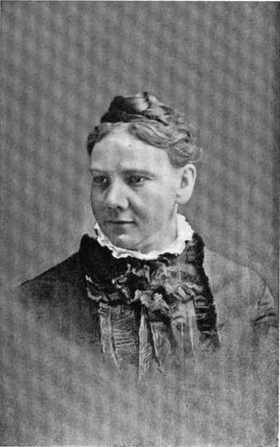Mary F. Eastman facts for kids
Quick facts for kids
Mary Frances Eastman
|
|
|---|---|
 |
|
| Born | 20 Oct 1833 Lowell, Massachusetts, U.S. |
| Died | 1 Nov 1908 Tewksbury, Massachusetts |
| Occupation | educator, lecturer, writer, suffragette |
| Alma mater | Lowell High School |
Mary F. Eastman (born October 20, 1833 – died November 1, 1908) was an important American woman. She was an educator, a speaker, a writer, and a suffragette. A suffragette was someone who worked for women's right to vote.
Mary was born in Lowell, Massachusetts. She lived in Tewksbury for many years. She taught at high schools and special schools for girls in Boston. Later, a famous educator named Horace Mann asked her to help with education in Ohio. She worked at Antioch College.
Mary was known for being a great teacher. She could teach and manage students well. She also taught in Charlestown and Somerville, Massachusetts. Mary believed that getting the right to vote was the most important step for women. She was famous for her speeches about women's rights. Mary Eastman passed away in 1908.
Contents
Mary Eastman's Early Life and Schooling
Mary Frances Eastman was born in Lowell, Massachusetts. She was the third child of Gardner Kimball Eastman and Mary Flanders Eastman. Sadly, two of her older brothers died when they were young. Mary had a sister named Helen, who was two years younger. Helen was her close friend throughout her life.
Mary's family, the Eastmans and the Flanders, came from England. Their ancestors were among the first settlers in Salisbury, Massachusetts, around 1640. Her father, Gardner Kimball Eastman, was born in Boscawen, New Hampshire. Her mother, Mary Flanders, was born in Warner, New Hampshire.
Mary was a very serious student. Once, she asked her older cousin and brother for help with math problems. They told her they were ashamed that a girl wanted to study math. But Mary did not give up!
She went to public schools in Lowell. She also took private classes in drawing, painting, and even horseback riding. She learned dancing and gymnastics too. After high school, she went to a special school for young ladies. Mary wanted the best education she could get. So, she went to a State Normal School in West Newton, Massachusetts. There, she found the excellent teaching she was looking for. This experience made her want to become a teacher.
Mary Eastman's Career
Becoming an Educator and Writer
Right after finishing Lowell High School, Mary was asked to lead the high school in Brookfield, Massachusetts. Later, when Antioch College opened in Ohio, Horace Mann invited Mary to be a student there. But her parents felt Ohio was too far away.
After she became a teacher, President Mann invited her again. This time, he wanted her to teach in the college's early classes. Many of her students were older than her! She stayed there until near the end of Mann's life.
After Mann's death, a minister from Argentina asked Mary to help. He wanted her to bring a school system like New England's to his country. Mary thought about it, but she felt she was too young and didn't have enough experience. So, she said no.
She returned to New England and became the head of the Female Department at Lowell High School. This was her old school, and it had almost 200 students. After four years, she left to lead a school for young ladies in Meadville, Pennsylvania. She lived with the Huidekoper family there for seven years.
Mary also wrote a biography about Dr. Diocletian Lewis. She wrote a section about the history of women's education in the Eastern States for a book called Woman's Work in America. In Tewksbury, she served on the school committee. She also helped start the public library and a group called the Village Improvement Association.
A Powerful Speaker and Suffragist
Mary started giving public speeches about education and other important changes. She also spoke about her travels and books. People really enjoyed her talks. One evening, she was at a party and started talking about women's right to vote. After the party, students invited her to speak more about it. This was her first public speech on the topic.
When she returned to Massachusetts, Lucy Stone, another famous suffragist, asked her to speak. This started many years of Mary giving speeches across the country. She spoke from platforms and sometimes even from pulpits (church speaking areas). This work was very important to Mary. She worked with other famous women like Lucy Stone, Susan B. Anthony, Elizabeth Cady Stanton, and Mary Livermore.
From the stage, she spoke about many topics. These included "Equal Suffrage" (women's right to vote) and "Progress in Education." She also talked about the "Rights and Wrongs of the Indians" and the "Duties of Government." She gave talks on literature and travel too. Her arguments were always clear and honest. She received a lot of support from her audiences, newspapers, and other leaders.
Mary Eastman's Published Works
- Representative women of New England, 1904

